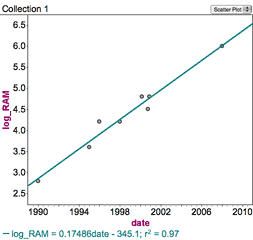- 2006.05.30
According to Windows
System Reqs. 1990-2006: More For Less, Windows requirements
have been growing for some time.
Here's an interesting analysis you can do to talk about modeling
in a science class or discuss with your geekish friends. People
have been extrapolating Moore's Law
forever and a day, but this article provides some less abstract
information than the usual size-of-a-transistor data cited in the
Wikipedia article.
The Yahoo article gives us RAM requirements on the various
versions of Windows since Windows 3.1. Using this data, I have
created a mathematical model of the amount of RAM needed by
Windows. This enables me to make entirely unreasonable (but
entertaining) extrapolations about the amount of RAM needed for
future versions of Windows I like to call
The Lite Side Extrapolates Windows RAM
Requirements
or
Some Other Snappy Title I'll Come Up With
Later
Using Fathom (a statistics program used for modeling), I plugged
in the values from the Yahoo article and generated the following
graph and least-squares line:

You'll note the growth is exponential, since I had to take the
log of the amount of RAM to make it a linear function.
Okay, so now we can plug in some numbers and determine the
following interesting predictions:
If current trends continue:
- by 2018 Windows will require 100 gigs of RAM. This is one byte
of RAM for every star in the Milky Way Galaxy.
- by 2022 Windows will require 500 gigabytes of RAM. (A child
born today will be 16 years old.)
- by 2024 Windows will require a terabyte of RAM.
- by 2040 Windows will require a petabyte of RAM.
- by 2052 one copy of Windows will require more RAM than
the entire Internet in 2003
- by 2107 one copy of Windows will have enough RAM to store a
byte for each molecule in a mole (Avogadro's number)
- by 2527 Windows will require a googol of RAM
- by the year 10,000 Windows will require 101403 K of
RAM - far larger than the number of known molecules in the
universe.
Some other interesting extrapolations:
The model predicts that Windows in 1985 would have required
about 100 KB of RAM. That is when Windows 1.0 was released, but its
system requirements are not in the article.
Using the same model, if Windows had existed in 1980 it would
have required about 13 KB RAM.
And if Windows had existed in 1960 it would have used just 4
bytes of RAM - just enough to display the Blue Screen of Death on a
7-segment display!
I am sure similar numbers would work for the Mac OS, but these
were all laid out nice and simple for me. Enjoy.



